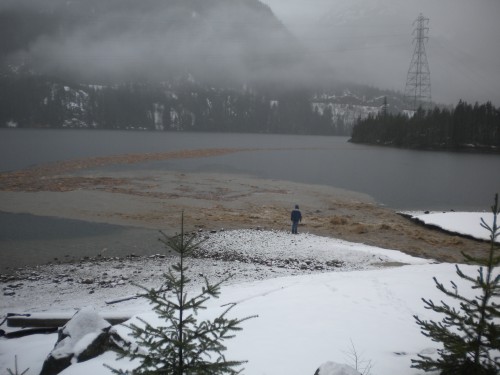Natural Shifts in the North Cascades

The sheer power of water was apparent in the North Cascades this last weekend after a recent Pineapple Express hit the Northwest. Warming temperatures combined with a significant amount of rainfall fell onto several weeks worth of snow in the Cascades. Consequently, mountain creeks filled to the brim and several landslides covered Highway 20, closing a stretch of this road between the towns of Diablo and Newhalem. Several M.Ed. graduate students and our graduate coordinator were staying at the North Cascades Environmental Learning Center and in the town of Diablo, and got to see this dynamic shift in nature first-hand.
At the Learning Center, the recent weather demonstrated how quickly land is shaped by water as we watched Sourdough Creek quadruple in size Sunday afternoon. This was an amazing shift to see as Sourdough typically runs as a trickle in late summer to a swiftly-flowing mountain creek in late spring. Sourdough Creek runs next to the Learning Center’s parking lot under a “Texas dip,” a removable piece of roadway designed to prevent washout. But this road feature was barely recognizable as the creek filled with brown, fast-running water that undercut the bank, causing large chunks of earth to collapse and wash away into Diablo Lake.
Large rocks and logs were swept down the creek, swirling and crashing in the fierce, turbulent water. The sound of tumbling rocks colliding down the creek were heard from as far away as upper campus. The air was filled with the smell of mud and pine. A long trail of debris flowed into Diablo Lake and across the impounded body of water. This was a scene of natural land-shaping as I had never seen before!
[vimeo width=”450″ height=”253″]http://vimeo.com/17785049[/vimeo]
Later Sunday afternoon, our creek receded to a flow similar to springtime conditions. By Monday morning, the water returned to its normally clear color. A foot of sediment and debris remained on the road, but was cleared later that morning by our dedicated partners with Seattle City Light. The impacts of the heavy flow remain apparent though, and are most likely representative of what occurred in other creeks in the North Cascades. The banks along Sourdough Creek have widened and several of its smaller trees have washed out. The beach where the creek enters Diablo Lake has significantly expanded with mud and large rocks.

Sourdough Creek overtakes the roadway and flows over the “Texas dip” as a result of the Pineapple Express that recently hit the Northwest.
Learning Center residents dig out portions of the snow bank to allow water from the creek to drain from the parking lot.
Logs and branches washed away from Sourdough Mountain create a long trail of debris into Diablo Lake.
A Seattle City Light employee clears debris from Sourdough Creek.
Sourdough Creek upon being cleared Monday after Sunday’s rainstorm. Photo by Nick Mikula
Sourdough Creek running under the “Texas dip” in late summer. Photo by Corey White
The section of Highway 20 between Diablo and Newhalem remains closed to general traffic. But road crews were able to clear enough of the highway to allow those of us in Diablo and the Learning Center to leave if needed. Several of us caravanned Monday evening in order to catch flights or meet with family for the winter holiday. While driving we saw evidence of the multiple land slides, many of which were a result of washed-out creeks. The heavy rains also birthed multiple waterfalls along the cliffs near the highway that are otherwise nonexistent in the summer.
I’ve lived in the lower Skagit Valley during other rain-on-snow events in the past. Down low, I’ve seen creeks and the Skagit River significantly increase in size, but I’ve never experienced what happens higher in the valley at the head of our watershed. Seeing this dramatic shift in nature provided a fantastic example of how our mountainous landscape is constantly shifting. Nature is not static, what we see today can quickly change tomorrow.







Hoo-ah! Glad to see that a firsthand look at nature’s power remains part of the at NCI residency tradition. Glad also you made it out in time for winter break.
I’m very proud of you and Jimmy & the work that you do, Codi….but, frankly, it would scare me to death to be up there in that weather! My hat is off to you many times over!! 🙂
I love it when mountains move and waterfalls reign (and when it all subsides in time to go home for the holidays)! Great story Codi.
Nature at work, constantly changing the landscapes of the North Cascades (as it does, but perhaps not as dramatically, everywhere). Codi, your story illustrates what a learning opportunity we (you) have living in a place like this, watching events that those of us out in the lowlands usually miss. Thank you for sharing this with us. I expect there will be more stories along this line to come this year – a part of me hopes so! A final thought – in this past decade it has seemed to me, as I try to plan trips in these mountains, that nature is making a concerted effort to take back these mountains from us “conquerors.” I wonder what happened on the Suiattle River, Miners Creek, Boulder Creek over by Stehekin, and the many other places where we “conquerors of nature” have presumed we were in charge. The caterpillar can clear the Texas dip, but it’s not so easy elsewhere.
Great story on a spectacular event – catastrophism in action! Sure gets one’s attention away from more “uniform” occurences – keep up the good work and good luck with the rest of winter!
Codi,
Thanks for the interesting article. I thoroughly enjoyed it.